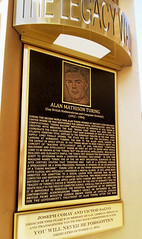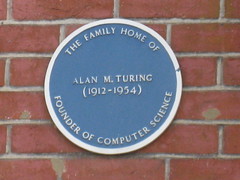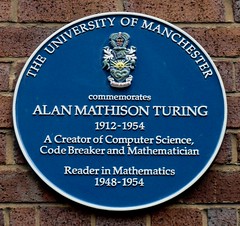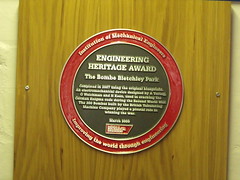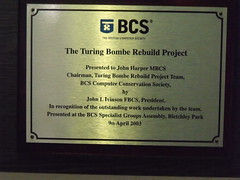Places, subjects, or plaques matching "Alan Turing"
1 subject matching "Alan Turing"
15 plaques matching "Alan Turing"
Alan Turing 1912 - 1954 mathematician, computer pioneer and code breaker
St Catherine's College Library - St Catherine's College - Trumpington Street, Cambridge, United Kingdom
Subjects
Alan Turing 1912-1954 founder of computer science and cryptographer, whose work was key to breaking the wartime Enigma codes, lived and died here.
43 Adlington Road, Wilmslow, United Kingdom
Subjects
Alan Turing 1912-1954 code-breaker and pioneer of computer science was born here
2 Warrington Cresent, Maida Vale, Westminster, W9, London, United Kingdom
Subjects
Alan Turing 1912-1954 code breaker and pioneer of computer science boarded here 1926-1931
Westcott House on Horsecastles, Sherborne, United Kingdom
Subjects
Alan Turing 1912-1954 code breaker lived here from 1945-1947
78 High Street, Hampton, London, United Kingdom
Subjects
Alan Turing 1912-1954 founder of computer science and cryptographer, whose work was key to breaking the wartime Enigma codes, spent his childhood here.
Baston Lodge, 1 Upper Maze Hill, St Leonards-On-Sea, TN38 0LA, Hastings, United Kingdom
Subjects
Alan Turing Code Breaker & Pioneer of Computer Science Love Lived Here 1912-1954
2 Warrington Crescent, London, United Kingdom
Subjects
White Cottage home to Alan Turing, Alan Hinsley, John Tiltman wartime codebreakers 1939-1946
Hanmer Road, Simpson, United Kingdom
Subjects
IEEE Milestone in Electrical Engineering and Computing Code-breaking at Bletchley Park during World War II, 1939-45. On this site during the 1939-45 World War, 12,000 men and women broke the German Lorenz and Enigma ciphers, as well as Japanese and Italian codes and ciphers. They used innovative mathematical analysis and were assisted by two computing machines developed here by teams led by Alan Turing: the electro-mathematical Bombe developed with Gordon Welchman, and the electronic Colossus designed by Tommy Flowers. These achievements greatly shortened the war, thereby saving countless lives.
Bletchley Park House, Bletchley Park, Bletchley, United Kingdom
Subjects
Alan Mathison Turing (Gay British Mathematician and Computer Scientist) (1912-1954). During the Second World War, Alan Turing worked at Britain's code-breaking center where he was responsible for German naval cryptanalysis. Using the computational “Turing Machine” methodology he invented in 1936, Turing is credited with breaking the Nazi “Enigma Code” which had been used to coordinate the U-boat juggernaut that sank hundreds of ships in the North Atlantic ferrying vital supplies to the European theater of the war. With supply lines finally opened, the stage was set for the successful D-Day landing at Normandy, turning the war to the Allies favor, leading to the defeat of Adolf Hitler. In 1947 Turing began to muse publicly about the concept of “machine intelligence” and, in 1950, published “Computing Machinery and Intelligence” where he first set out to devise what would come to be known as the “Turing Test” for Artificial Intelligence. Brilliantly realized and elegantly simple, the Turing Test remains the benchmark in the quest to determine when a computer becomes “self-aware.” In 1999, TIME magazine named Turing one of the 100 most influential scientists of the 20th century, stating that "everyone who taps at a keyboard, opening a spreadsheet or a word-processing program, is working on an incarnation of a ‘Turing Machine’." Turing lived in an era when homosexuality was still both illegal and officially considered a mental illness. In 1952, after being arrested for admitting to a sexual liaison with another man, he was convicted and sentenced to chemical castration. Two weeks before his 42nd birthday he bit into an apple laced with cyanide and ended his life. The tragedy of Turing’s suicide is trumped only by the loss to humanity that his death dealt to the field of Computer Science. Given all that he accomplished, it is impossible to overstate the potential magnitude of his unrealized contributions. Acknowledging Turing’s legacy, on September 10, 2009, British Prime Minister Gordon Brown issued an official apology for the government’s treatment of Alan Turing after the war.
3345 N. Halsted Street, Chicago, United States
The family home of Alan M. Turing (1912-1954) founder of computer science
22 Ennismore Avenue, Guildford, United Kingdom
Subjects
Alan Mathison Turing 1912-1954 A Creator of Computer Science, Code Breaker and Mathematician Reader in Mathematics 1948-1954
Coupland Street, Manchester, United Kingdom
Subjects
Alan Mathison Turing 1912-1954 a creator of computer science, code breaker and mathematician. Reader in Mathematics 1948-1954
Coupland Building 1, Coupland Street, M13 9PL, Manchester, United Kingdom
Subjects
Engineering Heritage Award The Bombe Bletchley Park Completed in 2007 using the original blueprints. An electromechanical device designed by A Turing, G Welchman and H Keen, used in cracking the German Enigma code during the Second World War. The 200 Bombes built by the British Tabulating Machine Company played a pivotal role in winning the war.
Block B - Bletchley Park , Bletchley, United Kingdom
Subjects
The Turing Bombe Rebuild Project Presented to John Harper MBCS, Chairman, Turing Bombe Rebuild Project Team, BCS Computer Conservation Society by John L Ivinson FBCS, President. In recognition of the outstanding work undertaken by the team. Presented at the BCS Specialist Groups Assembly, Bletchley Park 9th April 2003
Block B - Bletchley Park, Bletchley, United Kingdom

.jpg?width=250)

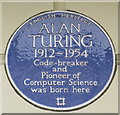
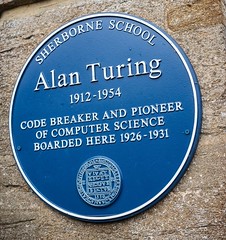




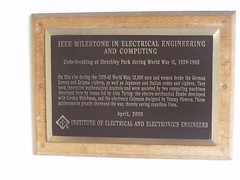



_-_Museo_scienza_e_tecnologia_Milano.jpg?width=250)
